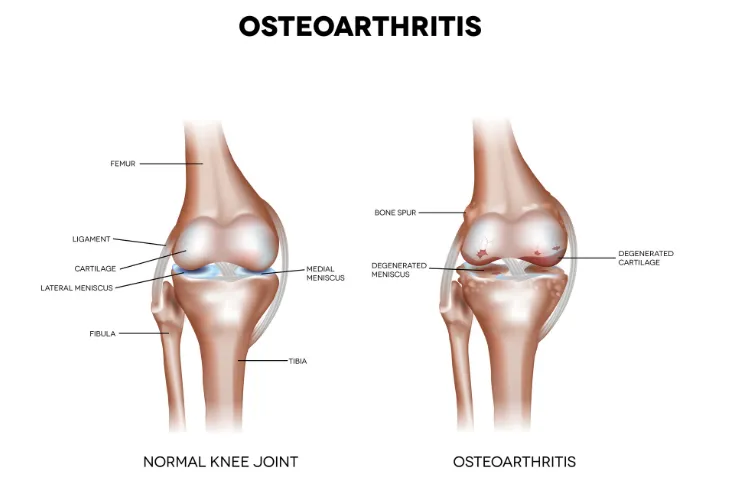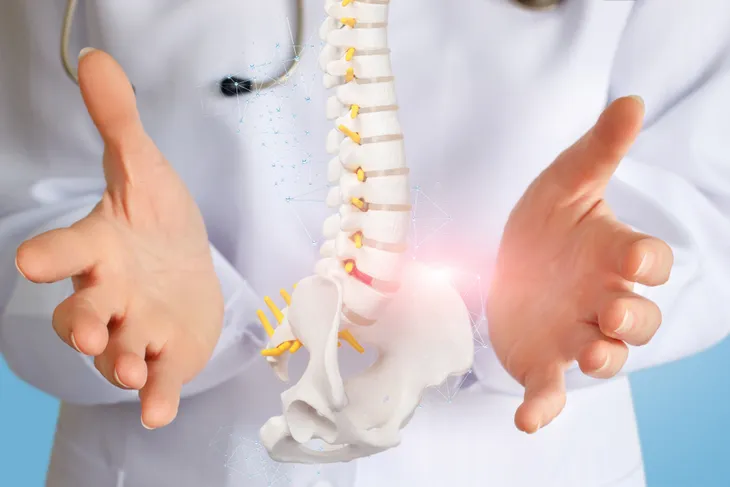- There are numerous conditions that can affect the spine and joints,
- Doctors and physical therapists perform assessments to determine spine and joint health.
- There are tests you can do at home to assess your own mobility.
- Lifestyle interventions can help you maintain a healthy spine and joints.
As you age, bone density, muscle mass, and strength decrease naturally, and reduction of cartilage thickness can lead to stiffer, less flexible joints. Lifestyle interventions such as regular weight-lifting, cardio, and stretching exercises can help protect mobility. However, there are also a number of medical disorders that affect the spine, joints, and bones.
Without assessment and treatment, these diseases can lead to disability and chronic pain. Spine, joint, and bone conditions are closely linked — the spine is made up of bones, muscles, joints, and ligaments, and joints are the intersection of two bones. The more you know about conditions affecting the spine and joints, the easier it is to get the correct diagnosis and maximize your quality of life.
Conditions Affecting Joint Health
Arthritis is the most common spine and joint condition, and one of the leading causes of disability in the United States. According to the CDC, 26% of U.S. adults over the age of 18 are projected to have a diagnosis of arthritis by 2040. There are many types of arthritis, in addition to other common joint conditions, such as:
- Osteoarthritis
- Rheumatoid arthritis
- Spondyloarthritis
- Juvenile idiopathic arthritis
- Lupus
- Gout
- Bursitis
Symptoms of Joint Issues
Symptoms of joint disease can be mild, but if left untreated they could get worse and make daily tasks difficult to perform. Keep in mind that it’s normal to experience some pain, stiffness, and decreased range of motion following exertion. If the following symptoms persist, you should consider setting up an appointment with your doctor:
- Pain
- Stiffness
- Instability
- Decreased range of motion
- Decreased joint function
- Bumps on finger joints
- Warm, soft painful swelling of knuckles, wrists, and hands
Conditions Affecting Spine Health
The potential for spine disease increases as you get older. A study in the Medical Advisory Secretariat shows that 40-percent of people 40-years or older have degenerative disc disease, a statistic that rises to 80-percent in individuals aged 80 plus. Common conditions include:
- Arthritis
- Degenerative disc disorders
- Herniated disc
- Spondylosis
- Spinal stenosis
- Ankylosing spondylitis
- Cranial settling, basilar impression, and basilar invagination
- Chronic pain
- Osteoporosis and vertebral fractures
- Kyphosis
- Scoliosis
- Spinal cord injury
- Cancer and other types of tumor
- Spondylolisthesis
Symptoms of Spine Disorders
Common symptoms of a spine disorder include:
- Neck or back pain
- Abnormally rounded back or shoulders
- Bladder or bowel dysfunction
- Pain in legs and arms
- Nausea
- Tightness and stiffness
- One shoulder or hip higher than the other
- Numbness, weakness, or tingling in arms and legs
If you experience any symptoms of a spine disorder, get in touch with your primary care physician as soon as possible. The spine is very complex, with 31 pairs of nerves and millions of connections to the brain. There are 33 vertebrae, 23 discs, and around 40 back muscles. The sooner you get a diagnosis, the better.
How Are Joint Pain Symptoms Evaluated?
Joint disorders such as arthritis have an array of potential causes, including auto-immune disease, infection, inflammation, crystal-induced inflammation, and bone disorders. While joint pain is a primary sign of the disease, there are a range of other symptoms a doctor or physical therapist assesses to diagnose a condition.
When you see a medical professional to get a diagnosis for the condition affecting your joints, they might perform a variety of tests. Some of these include a physical exam, blood tests, imaging tests, and more. Let’s take a closer look at these next.
Physical Examination and Blood Tests
Your doctor will likely start by examining the affected joints, with an estimation of the range of motion for each one. Their resting position is analyzed alongside the presence of punctures, abrasions, deformity, swelling, and erythema. The presence of swelling, warmth, and tenderness is noted, and the doctor determines whether there’s tenderness over tendons or along the joint line.
Once the doctor performs an examination, there are a number of blood tests that can help support the diagnosis of a joint condition.
Other Possible Tests
Your doctor may require further testing to confirm a diagnosis. Some of these include:
Imaging studies: While imaging mainly detects bone disorders, it can be useful in assessing whether tumors, osteomyelitis, or calcification are present. What’s more, it could help detect abnormalities related to osteoarthritis, gout, or rheumatoid arthritis.
Arthrocentesis: This process involves puncturing the joint to draw synovial fluid and exclude diagnoses of crystal-induced arthritis or infection.
Synovial fluid examination: During the assessment of the synovial fluid, the doctor initially assesses color and clarity to give a preliminary indication of inflammation or infection. Lab tests might include cell count, Gram stain and culture, leukocyte differential, and wet drop examination for crystals and cells.
How Does a Doctor Assess the Spine?
As a person gets older, the likelihood of back pain becomes increasingly more likely. When you go to a health professional with back pain, the first step is a review of your medical history, followed up by a series of questions, such as:
- Have you ever experienced injuries that might contribute to back pain?
- Are conditions such as osteoporosis or bone conditions present in your family?
- When did you first experience pain, where did it originate and how intense is it?
- Have any body positions relieved or intensified the pain?
- Do you have any issues with your bladder or bowels?
Testing
If pain has been present for two weeks or more without improvement, the doctor is likely to perform a series of tests. Depending on your individual symptoms, doctors might recommend any of the following tests:
CT scan: This type of scan uses specialized radiation to provide 3D, cross-sectional images of the spine. CT scan images contain more detail than a traditional x-ray, helping to evaluate bone disorders or injuries.
MRI scan: An MRI scan uses a strong magnet and radio waves to produce a detailed image of the spine. Unlike a traditional x-ray, it can detect disorders with soft tissue, including muscles, tendons, ligaments, nerves and the spinal cord.
X-ray: A doctor might also use traditional x-rays of the neck and back to detect fractures, chronic disorders or other injuries.
Biopsy: If there’s a potential for cancer, a surgeon might take a tissue sample to analyze under a microscope.
EMG: An EMG can measure electrical activity generated by nerves and muscles and help doctors understand how different body areas respond to stimuli.
Treatment for Joint Conditions
In some cases, there might not be a cure for joint pain caused by conditions such as arthritis. Other times, the pain might be relieved by medication, surgery, physical therapy, or at-home exercises. Treatment includes:
- Regular hot and cold therapy
- Swimming, walking, stretching, and other low impact exercises
- Weight loss might be recommended to relieve pressure on joints
- Anti-inflammatory medication
- Painkillers
- Topical ointments or gels
- Dietary supplements
- Canes, braces, or orthotic shoe devices
- Occupational or physical therapy
- Steroids
Treatment for Spinal Conditions
A spine specialist might use one or more of the following treatments to relieve pain and ease symptoms associated with spine disorders:
- Back brace
- Ice and heat therapy
- Radiation therapy, chemotherapy, radiation therapy, or surgery to remove tumors
- Steroid injections for pain
- Muscle relaxant, pain relief, or anti-inflammatory medication
- Surgery to repair nerves, open the spinal canal, fuse vertebrae, or replace discs
- Physical therapy to stretch and strengthen the back and abdominal muscles
 novak.elcic / Shutterstock
novak.elcic / ShutterstockWhat You Can Do to Promote Spine and Joint Health
Taking care of your spine and joints is something you should aim to do every day, whether you currently have any pain or not. You can implement daily habits to promote supple, mobile joints and a healthy spine.
Exercise
Make exercise part of your daily routine. That doesn’t mean you have to become a marathon runner or take up a sport. Walking, cycling, yoga, and dancing are effective, fun, and easy to integrate into daily life. Movement helps distribute nutrients around your body, reduce inflammation and strengthen bones and muscles. Find the time that suits you best and aim to do something active for at least 20 minutes every day.
Meditation isn’t necessarily about achieving enlightenment or being more spiritual. It’s simply a way of clearing your mind and encouraging more mindfulness. Just 15 minutes a day of focusing on breathing can help reduce back pain.
Posture
Being more intentional about your sitting posture can help prevent spine and joint issues. If you type a lot of work in an office-type setting, be sure to pay attention to ergonomics and use tools such as wrists pads, or supports.

Foods that are highly processed are thought to contribute to inflammation. Limiting them to occasional treats and focusing more on whole foods can improve spine and joint health.
Massage
While a massage might sound indulgent, it can be a great way to promote spine and joint health. Put aside some money (or take advantage of your insurance benefits) for a monthly massage or get a loved one to give you a regular gentle massage if possible. You can even perform a self-massage using a foam roller or tennis ball.
If you have pain in your joints or spine, don’t hesitate to get an assessment from a medical professional. The earlier you get treatment, the better.















